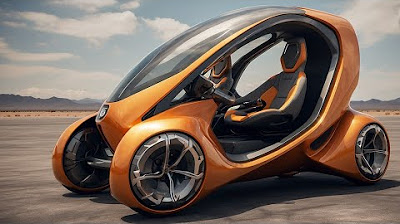Emerging Technologies That Will Change The World
Summary
TLDRThis video explores groundbreaking technologies set to revolutionize our world. From 3D-printed hearts to giant exoskeletons for construction and racing, the innovations are vast. Microrobots with potential medical applications, ferrofluid with its unique properties for targeted drug delivery, and futuristic footwear like the City Glider are featured. The video also delves into nuclear fusion's promise via tokamaks, aeroponic farming for sustainable food production, and smart tattoos like DuoSkin. It touches on climate-resilient architecture with the Ark concept and advancements in jet engines for greener aviation. The segment on graphene's potential and the Hyperloop's ambitious transportation goals rounds out the future-tech landscape, concluding with generative AI's impact on creativity and the economy.
Takeaways
- 🧬 In 2019, Tel Aviv University researchers created the world's first 3-D printed heart using human stem cells, offering a potential solution for heart disease treatment.
- 🤖 Exosapien Technologies developed a massive, four-legged exoskeleton named Prosthesis, suggesting future possibilities in mech sports and heavy industry.
- 🦀 Northwestern University engineers unveiled some of the world's smallest remote-controlled robots, which could revolutionize fields like micro-manufacturing and medical procedures.
- 🌌 Ferrofluid, a liquid with magnetic properties, has potential applications in loudspeakers and medical science, including targeted drug delivery.
- 👟 The City Glider, a high-tech footwear concept, aims to increase walking speed and reduce the reliance on motor vehicles for short distances.
- ⚡ MIT researchers are experimenting with nuclear fusion using high-temperature superconducting electromagnets, which could lead to nearly limitless clean energy.
- 🌱 Aeroponics, a soil-less farming method, uses 90% less water and can produce healthier crops faster, offering a sustainable solution for food production.
- 🏗️ DuoSkin, a smart tattoo developed by MIT and Microsoft Research, can turn skin into a wearable Bluetooth trackpad, showcasing the potential for skin-integrated technology.
- 🪰 Scientists at the Riken Research Institute in Japan have created cyborg cockroaches that can be remotely controlled, which might be used for search and rescue operations.
- 🌊 The Ark, a concept for a self-sustaining floating hotel, is designed to withstand the effects of climate change, representing innovative architecture for future living.
Q & A
What was the first 3D-printed human heart created by Tel Aviv University made from?
-The first 3D-printed human heart was created using human stem cells mixed with a gel-like 'bio-ink' made of modified proteins and collagen.
How does the 3D-printed heart technology potentially change the treatment of heart disease?
-This technology could allow doctors to print partial or full-size functional hearts from a patient's own stem cells, eliminating the need for donor organs and reducing the risk of incompatibility.
What is the Prosthesis exoskeleton developed by Exosapien Technologies and how does it function?
-The Prosthesis is the world's largest four-legged exoskeleton, standing 14 feet tall and weighing 9,000 pounds. It operates on 200 horsepower and can gallop at speeds of up to 21 miles per hour.
How could the Prosthesis exoskeleton technology be utilized in the construction industry?
-The industrial-grade hydraulic limbs of the Prosthesis amplify the pilot's strength by 50 times, allowing for the easy lifting, dragging, or crushing of large and heavy objects.
What are the applications of the microrobots developed by Northwestern University?
-These microrobots could be used in manufacturing to assemble or repair microscopic components, or in medicine for minimally invasive procedures such as clearing clogged arteries or eliminating tumors.
What is ferrofluid and how does it behave in the presence of a magnet?
-Ferrofluid is a material composed of magnetic iron oxide nanoparticles suspended in a carrier fluid. It acts as a liquid but can form spiky, organized structures when near a magnet, aligning with the magnetic field lines.
How could ferrofluid be used in medical science according to the script?
-Ferrofluid could be used for magnetic drug targeting, where medication is immersed in ferrofluid and directed to specific targets in the body using changing magnetic fields.
What is the City Glider and how does it assist in walking?
-The City Glider is high-tech footwear that compresses hydraulic pistons with each step, releasing the pressure to propel the wearer forward, increasing walking speed and distance.
How does magnetic confinement fusion work in the pursuit of clean energy?
-Magnetic confinement fusion heats hydrogen isotopes to form plasma, which is then contained and pressurized by an electromagnetic field inside a tokamak, potentially leading to fusion and energy release.
What is the significance of the high-temperature superconducting electromagnets developed by MIT?
-These electromagnets can create stronger, longer-lasting fields than copper coils, reducing plasma cooling in fusion reactions, and allowing for more compact and efficient tokamak designs.
What is aeroponics and how does it benefit agriculture?
-Aeroponics is a method of growing plants without soil, where roots are suspended and misted with nutrient-rich water. It uses up to 90% less water, reduces vulnerability to pests and diseases, and can produce healthier crops faster.
Outlines

Cette section est réservée aux utilisateurs payants. Améliorez votre compte pour accéder à cette section.
Améliorer maintenantMindmap

Cette section est réservée aux utilisateurs payants. Améliorez votre compte pour accéder à cette section.
Améliorer maintenantKeywords

Cette section est réservée aux utilisateurs payants. Améliorez votre compte pour accéder à cette section.
Améliorer maintenantHighlights

Cette section est réservée aux utilisateurs payants. Améliorez votre compte pour accéder à cette section.
Améliorer maintenantTranscripts

Cette section est réservée aux utilisateurs payants. Améliorez votre compte pour accéder à cette section.
Améliorer maintenantVoir Plus de Vidéos Connexes

15 Emerging Technologies that Will Change the World

10 Unbelievable Future Technologies That Will Change The World In Your Lifetime

15 New Future Technology Predictions for 2030 That Will Change The World

15 Futuristic Technologies That Will Change The World

20 EMERGING TECHNOLOGIES THAT Will Change Our World | Upcoming Life Changing Technology 2050

20 Emerging Technologies That Will Change The World
5.0 / 5 (0 votes)
